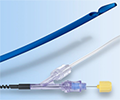
December 2018 Br J Cardiol 2018;25:152–6 doi:10.5837/bjc.2018.032
Telal Mudawi, Mohamed Wasfi, Darar Al-Khdair, Muath Al-Anbaei, Assem Fathi, Nikolay Lilyanov, Mohammed Elsayed, Ahmed Amin, Dalia Besada, Waleed Alenezi, Waleed Shabanh
Abstract

Figure 1. A thrombus aspiration catheter
Introduction
The use of thrombus aspiration in primary percutaneous coronary intervention (PPCI) for ST-elevation myocardial infarction (STEMI) has been subject to intense scrutiny and debate over the last decade. Clinical trials have been undertaken, using varying randomisation methodologies, aiming to objectively quantify the impact of the practice, while several subsequent meta-analyses have been conducted with conflicting results. Uncertainty remains and no exclusive guidance has been internationally agreed regarding the definitive usefulness, or otherwise, of the practice. The use of thrombectomy
|
Full text

May 2010 Br J Cardiol 2010;17:111-5
BJ Cardio Staff
Abstract

ACCORD/INVEST: do not aim for normal blood pressure in diabetes patients with CAD
The results of two trials comparing intensive versus more conventional blood pressure lowering in patients with diabetes at high cardiovascular risk have suggested that intensive treatment is not necessary and may be harmful in this population.
In the ACCORD BP (Action to Control Cardiovascular Risk in Diabetes – Blood Pressure) trial, while intensive blood pressure treatment did reduce the risk of stroke, it failed to reduce the overall risk of cardiovascular events in patients and was associated with an increase in adverse events due to antihypertensive ther
|
Full text




